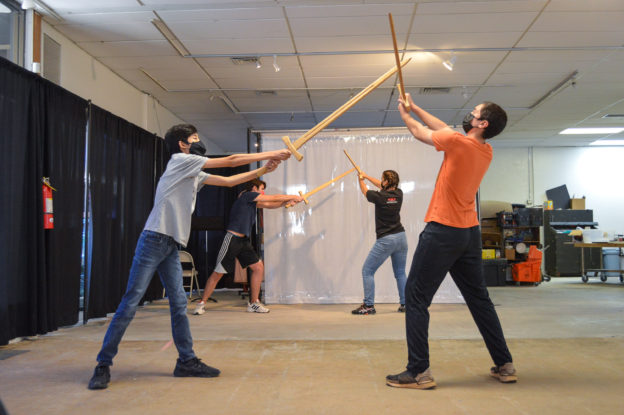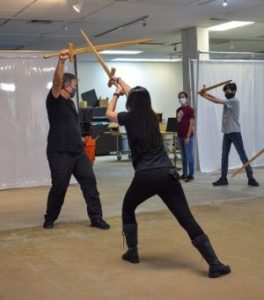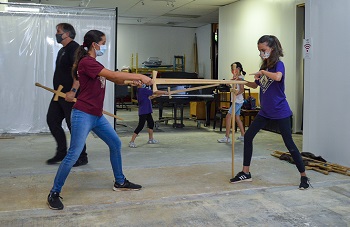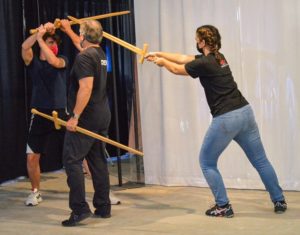
Safety in Stage Combat
Orvis Young Voices Studio Artists Receive Important Lessons In Fight Choreography From Master Instructor Tony Pisculli
With national conversations around safety and consent in the entertainment industry, teaching the art of stage combat has never been more important. Over the weekend, students of the Orvis Young Voices Studio received an introduction to the world of fight choreography from none other than Dueling Arts International Master Instructor, Tony Pisculli. Tony, who has been teaching stage combat and choreographing fights for over 20 years, has worked with every major theatre on Oahu—including Hawai‘i Opera Theatre.
 Together with his assistant Kathryn Lee, Tony led our young artists through a hands-on workshop in Broadsword work, beginning with a brief warm up and culminating in drills of Moulinet and Parry 5 between distanced partners. Among the technical instruction he provided were tips of the trade, like using a ‘shaka’ away from the heart to the tip of the sword as a measurement for safe distance with partners. Emphasizing that storytelling happens in the body, Tony coached the students in shifting weight and energy—creating long lines through the body that extend beyond the sword—demonstrating commitment and intention of movement. He also prioritized clear eye contact between partners, not only to convey story, but also for safety. But above all, Tony instilled a very important lesson for our young artists—speak up and use your voice!
Together with his assistant Kathryn Lee, Tony led our young artists through a hands-on workshop in Broadsword work, beginning with a brief warm up and culminating in drills of Moulinet and Parry 5 between distanced partners. Among the technical instruction he provided were tips of the trade, like using a ‘shaka’ away from the heart to the tip of the sword as a measurement for safe distance with partners. Emphasizing that storytelling happens in the body, Tony coached the students in shifting weight and energy—creating long lines through the body that extend beyond the sword—demonstrating commitment and intention of movement. He also prioritized clear eye contact between partners, not only to convey story, but also for safety. But above all, Tony instilled a very important lesson for our young artists—speak up and use your voice!
 Consent is a crucial component to the art of stage combat. Though the goal is to create the illusion of violence to tell a story—not actually recreate violence—even those illusions can be dangerous or feel uncomfortable at times. Tony stressed the importance for all artists, whether young students or seasoned-professionals, to feel safe emotionally and physically. He shared that sometimes it feels harder to say NO or STOP when on set or in rehearsal. Instead, he introduced two valuable industry terms that can be used to create a safe environment for all—HOLD and BUTTON.
Consent is a crucial component to the art of stage combat. Though the goal is to create the illusion of violence to tell a story—not actually recreate violence—even those illusions can be dangerous or feel uncomfortable at times. Tony stressed the importance for all artists, whether young students or seasoned-professionals, to feel safe emotionally and physically. He shared that sometimes it feels harder to say NO or STOP when on set or in rehearsal. Instead, he introduced two valuable industry terms that can be used to create a safe environment for all—HOLD and BUTTON.
 HOLD is used when a situation feels dangerous and needs to stop immediately before someone gets hurt. BUTTON is used to take a pause when there is a concern that needs to be addressed before someone feels comfortable to proceed. Before our young artists even picked up a sword, they practiced using these terms to communicate their needs with each other. It was a small but important piece of the workshop that will prepare our artists to encounter situations both on and off the stage with the tools to ensure their safety and well being.
HOLD is used when a situation feels dangerous and needs to stop immediately before someone gets hurt. BUTTON is used to take a pause when there is a concern that needs to be addressed before someone feels comfortable to proceed. Before our young artists even picked up a sword, they practiced using these terms to communicate their needs with each other. It was a small but important piece of the workshop that will prepare our artists to encounter situations both on and off the stage with the tools to ensure their safety and well being.
